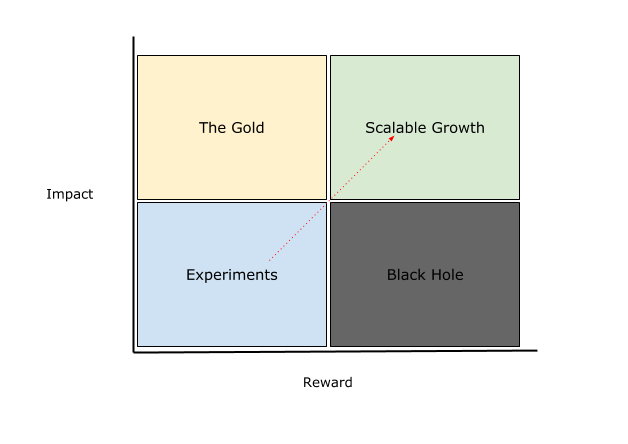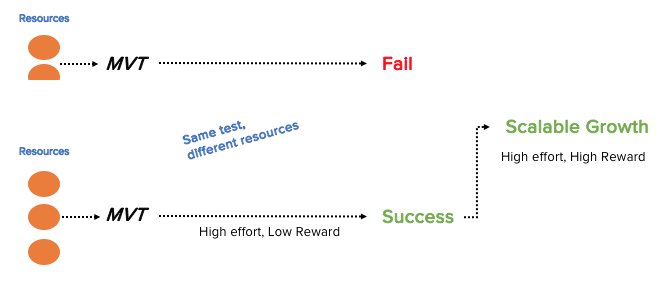When I first started getting serious about online marketing, I spent a lot of time trying to figure out affiliate marketing.
I mean, traveling the world non-stop, working four hours a week, earning millions a year, what's not to love about the affiliate life :)
Affiliate marketing was my "side hustle," after working 50 hours a week on SEO for clients; I worked late into the night on affiliate marketing.
It was exhausting, and the results I achieved in my first year weren't enough for me to start my jet-setting life.
When I looked back on that first year in affiliate marketing, I had allowed my time to be sucked into the black hole of high effort, low reward work. I was doing a lot of different things that required a lot of effort but were not going to have a real impact on my results.
For companies that are trying to move from a start-up to a scale-up, retention may be a silent killer, but that black hole will bring their growth to a grinding halt.
The Effort vs. Reward Growth Matrix
When you're leading a marketing or growth team in a high growth company, you need to become extremely proficient at where your team is expending their energy.
One lens I like to measure a lot of decisions through is this simple 2*2 matrix.

There are four possible quadrants you and your team can be working in:
1. The Gold
Ahhhh, the low hanging fruit. The list of things a marketer can do that takes a minimum amount of effort but will result in a high reward.
Do these things exist?
In my experience, the answer is, yes, but in companies where marketing is in its infancy.
For example, I've spoken to companies who have a considerable user base, because their product is fantastic and is growing via word of mouth, but they've never sent an email to that base or created any onboarding for new users.
That kind of gold makes someone like me kinda drool with excitement :)
"Wait, you haven't even sent an email yet?"

These are very difficult to find in companies that have been doing marketing *well* for a medium amount of time. You can potentially find them on emerging channels where there is still some potential upside from being a first mover.
Anything in this quadrant gets prioritized.
2. The Experiments
The experiment quadrant is those things you do that are low impact, low reward. You do them because there is potential to move these into the scalable growth bucket. They are your minimal viable tests.
If you and your team are doing a bunch of things in here, with zero plans on how you move them into scalable growth, it's worth asking how necessary are these tasks.
3. Scalable Growth
Anything that's worth doing takes effort, unfortunately. As humans, we often don't like to admit that.
Instead, we'll listen to endless amounts of motivational content from people like Gary V in the hope of discovering that one golden nugget to transform our success, when all of it can be summarized by - it's going to take hard work or as Gary would say - "yo, fucking hustle dude."
The experiments you run will turn into a couple of plays to go deep in that generate a disproportionate amount of your growth, or at least that's how it should work :)
4. The Black Hole
The black hole is growth killer; it's something you need to be aware of, and always be plotting a course to navigate away from it.
It's easy to get sucked into, people do so with the best intentions, in particular when you have growing teams. Everyone wants to make an impact and feels their project is important.
As a leader adhering to this matrix often means making tough calls, telling people what their doing isn't impactful enough, and that as a team you're doubling down on a couple of plays that will generate better returns.
The tough part about being a leader is you have to tell your team what they need to hear vs. what they want to hear.
Do you ever work on things that are in the black hole?
I'm sure there are always cases. The main one I would advocate for is when you need to invest a substantial amount of resources into running an experiment to prove if something is going to be viable or not e.g. taking big swings.

In the above example, it's the same experiment with different results because of the resources we've allocated to them.
In the first case, we could have given up on a great opportunity because we initially didn't allocate enough resources to make the minimum experience good enough to validate the test.
Sometimes the *minimum* experience you need to reach can initially mean a higher investment than you're comfortable with, dragging you into the high effort for low reward bucket (the Black Hole).
But the goal is the same as your experiment bucket, you want to bring it up to the scalable growth quadrant, it's just a bigger risk if it fails, as many tests do, because you've invested a lot more upfront.
I'm a big fan of taking some big swings, if you don't, you're going to end up at a point where you're just iterating to the point of marginal gains, and have zero chance of making a real step change in your results.
Topics: Growth

